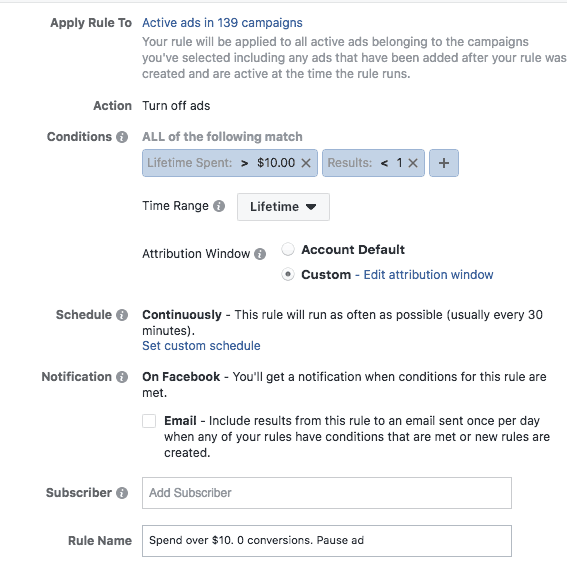If you’ve ever wondered how to get your Facebook campaigns set up for success, you’ve come to the right place. We’ll cover the basics as well as some advanced tips to give yourself a leg up on your competitors.
This is the Search Scientists Facebook Ads Guide.
Part One - Segment As Much As Possible
Facebook has an extremely intuitive and in-depth targeting system, meaning you can keep testing until you hone in on your ideal customer, and be certain you’re spending your advertising dollars in the right places.
Do you know if your product or service lends itself more to women or men? That’s an easy split test you can do by ad set within every campaign. Beyond that, what about age range? Are 18-25 year olds window shoppers, compared to 26-35 year olds, who might be more serious about buying? Split those age groups to find out.
Maybe you sell a seasonal product. You shouldn’t waste your targeting dollars advertising to people in Michigan during January, when you could be allocating more dollars to people in Florida, where the weather is milder that time of year. With Facebook, geographic segmentation is quick and easy.
The list of segmentation possibilities goes on. Gender, age, location, level of schooling, income level, interests, even recent life events, such as newly engaged or recently moved.
The more you’re able to segment, the more you’ll be able to determine from your tests running ads.
With all the segmentation you can do, it can get messy, which bring us to our next point.
Part Two - Stay Organized
Imagine logging into your Facebook Ads account, and you aren’t struggling to navigate through your campaigns, knowing exactly where your under-performing ads live, as well as your high performing ads.
Creating a detailed campaign road-map for your Facebook Ads, complete with different campaign types, goals, audiences, and targeting, is extremely useful to help you save time and headaches trying to wade through dozens, if not hundreds, of ad sets.
Breaking down each campaign, we recommend you have at least the following denoted in your campaign names:
Campaign Type/ Objective
- a. Drive Traffic
- b. Shopping
- c. Video Views
-
-
-
Targeting Type
- a. Interests
- b. Remarketing List
- c. Lookalike Audience
- d. Demographic Targeting
Device Type
- a. Desktop
- b. Mobile Devices
-
-
-
-
Ad Placement
- a. Newsfeed
- b. Right Hand Side
- c. Audience Network
- d. Instagram
Repeat the process within each ad set as needed. If you’re splitting your ad sets by men and women, denote that in the Ad Set name. The same with age, etc.
Once at the Ad Naming stage, you can name each individual ad just like the ad set it belongs to, but then add a descriptor of the image. Man in a blue shirt? Tag on “blue shirt man” on the end. Maybe it’s a picture of your featured bamboo sunglasses. You can add “hero bamboo sunglasses” to the end of your ad so you can quickly identify if these images are performing, and with what targeting.
The more work you do up front to stay organized, the more headaches you’ll save yourself down the road.
Part Three - Safeguard Your facebook ads Account
Once you have your campaigns and ad set running to your liking, it’s time to install some safety nets, to give yourself some peace of mind your account isn’t running your wallet dry.
Facebook Ads Automated Rules are an excellent way to help keep an additional pair of *digital* eyes on your account.
One of the most useful rules we can recommend installing is a High Spend/No Conversion rule.
How to set the High Spend/No Conversion rule up
First, determine what you’re willing to spend before getting a conversion. This may vary by campaign type. If you’re targeting cold traffic with interests, you may be comfortable spending more. But with a already engaged remarketing audience, the viewers are further down the sales funnel, and thus are more apt to convert. In these campaigns you may have a harder line for what you’re willing to spend on an ad or within an ad set before you see results.
Creating the rule is quick and easy, you plug in your variables, determine what action the rule will take, and activate it. That’s all! You’re now automatically safeguarded against a poor performing ad. Check out the example below:

You can apply the rule to one specific area of your account, or blanket your entire account. Choose if you want the spend amount to be the lifetime of an ad set, or just the last 30 days. Name your rule, and you’re in business.
Use automated rules to help you keep track of:
- High Spending Ads / Ad Sets
- Disapproved Ads
- High Frequency
- Low Ad Relevance Scores
And speaking of ad relevance scores…
Part four - facebook Ads Relevance Scores
Relevance score is a measuring stick for both the engagement level of an ad, as well as the quality of the ad. It helps determine what cost per click you can achieve, and how frequently an ad is shown.
Relevance score is made up of a number of components:
- Campaign Objective
- Audience Definition
- Ad Relevance
- Expected Feedback
If you’re looking for your relevance scores, but nothing is showing, it’s important to know that Facebook won’t assign your ad a score until it’s had about 500 impressions. So it’s possible your ad needs more time to gather those impressions before you can review and make decisions on how to improve them.
the search scientists facebook ads guide Wrap-up
- Segment, segment, segment (by gender, age, location, level of schooling, income level, interests, recent life events).
- Create a detailed campaign road-map (with different campaign types, goals, audiences, and targeting).
- Use automated rules (to help you keep track of high spending ad sets, disapproved ads and so on).
- Let the Relevance Score guide your ad content (tweak your ads so that you get higher levels of engagement).
Make sure to subscribe to our newsletter below for more Facebook Ads tips. And don’t forget to subscribe to the Search Scientists YouTube channel.

